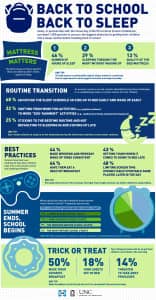As children go back to school this month, parents across the country will look to instill a regular sleep schedule that may have been lost during the summer months. Sealy and the University of North Carolina School of Medicine’s Neurodiagnostics and Sleep Science (NDSS) Program have joined forces to help American families make the schedule shift from summer to back to school.
Sealy commissioned and released the findings of a recent back-to-school, back-to-sleep survey showcasing the sentiment of more than 1,000 parents with children between the ages of 5-17 on topics such as sleep quality, schedules, and tactics to adjust to new routines. In conjunction, the UNC NDSS developed 7 tips to assist parents in planning for a more seamless back-to-school transition. When surveyed, nearly half of parents (46%) say the biggest impact on their child’s quality of sleep is the number of hours of sleep, with more than a quarter of parents (29%) saying that sleeping through the night has the biggest impact on their child’s quality of sleep. The third biggest impact–making sure a child has a quality mattress. Thirteen percent of parents say the quality of the mattress has the biggest impact on how their child sleeps, with that percentage rising among parents of younger children aged 5-9 to 17%.
“As summer winds down, families across the nation are looking for ways to ease their children back into their school schedule,” says Jay Spenchian, executive vice president and chief marketing officer at Tempur Sealy, in a release. “Through our survey findings and partnership with UNC School of Medicine’s Sleep Science Program we know the importance of equipping families with the right tips and tools to ensure that children are rested and ready to excel in the classroom.”
Many American families are struggling with finding that perfect balance between back-to-school schedules and summer fun. More than two-thirds (68%) of parents say adjusting the sleep schedule so kids go to bed early and wake up early is the biggest challenge to re-establishing a routine. Additionally, when it comes to shifting to a new routine, nearly a quarter (22%) of parents say that fighting the urge to shun schedules and have their children enjoy the last few days of summer is their biggest challenge.
“When dealing with time shifts, it takes about one day to adjust for each hour of time change, but this varies between individuals. Depending on your child, we suggest gradually moving closer to the intended school schedule one to two weeks before school starts,” says Mary Ellen Wells, PhD, RPSGT, R.EEG T, R.NCS T., clinical assistant professor and neurodiagnostics and sleep science program director, UNC School of Medicine, University of North Carolina at Chapel Hill. “Creating a relaxing bedtime routine, and associating your child’s bed with sleep can also help, which means keeping ‘sleep stealers’ out of the bedroom, such as computers, smart phones, TV, etc. The sleep environment should be restful–meaning dark, quiet, comfortable and not distracting.”
UNC School of Medicine’s Sleep Science Program has provided these 7 tips to help families transition from those last few moments of summertime fun to a productive, cohesive family sleep schedule.
- Bedtime Shift: Starting a week or two before school starts, determine the number of hours your child’s bedtime needs to shift and gradually advance the bedtime and wake time to the appropriate time (by no more than 30 minutes per day).
- Night Owls No More: No late bedtimes. The recommended number of hours of sleep differs for each age group. According to the National Sleep Foundation, school age (5-10 years) should get 10-11 hours and teens (11-17 years) should get 8.5-9.5 hours.
- Boycott Late-Night Electronics: Turning off electronics in the evening 2 to 3 hours before bedtime is a good rule of thumb. Any type of electronic device that emits blue light or revs up brain activity counteracts the body’s natural transition to sleep.
- The Mattress Matters: To help ensure a comfortable night’s sleep, invest in a mattress that is engineered to fully support the back and align the body.
- Break up with Snooze: Don’t allow your child to sleep in. Keep wake times consistent across both school days and weekends.
- The Breakfast Benefit: Make breakfast a priority and serve it at a consistent time each morning. Not only will kids be energized for the day, but a nutritious start helps them learn more effectively.
- Take Your Cue: There are external cues that help synchronize our sleep/wake rhythm. The sun is by far the most powerful environmental cue, which can be used to help us orient to our desired routine. Have your child get sunshine in the morning soon after waking.






